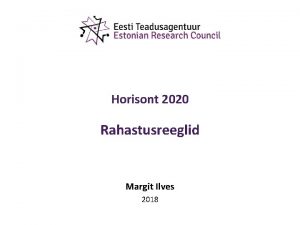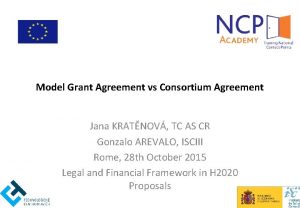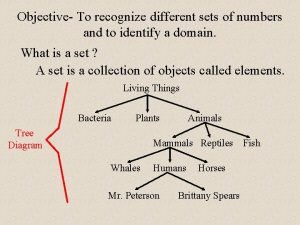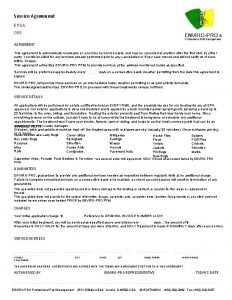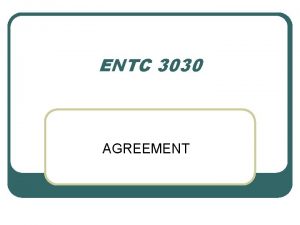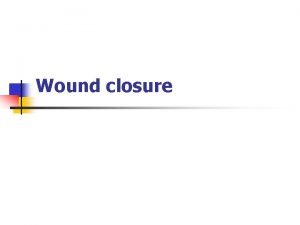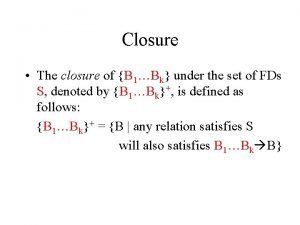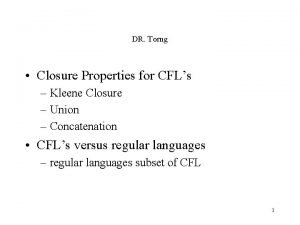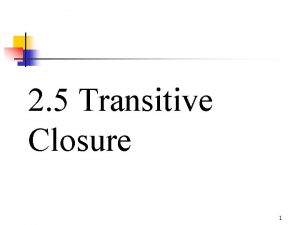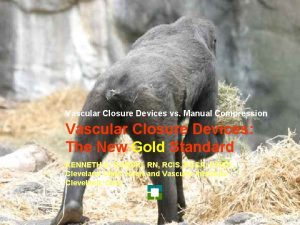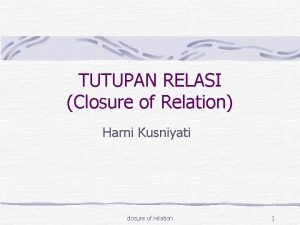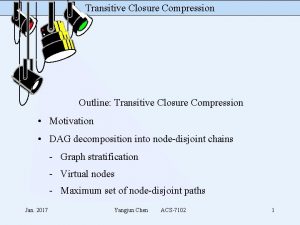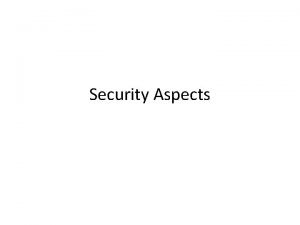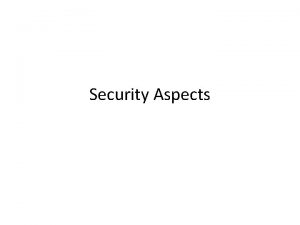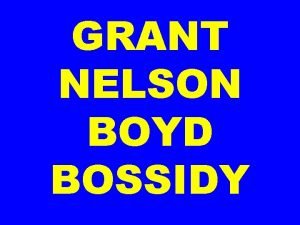Financial aspects of the grant agreement Financial Closure


















































- Slides: 50

Financial aspects of the grant agreement Financial Closure Web. Ex 11 December 2019 – 10. 30 - 11. 30 17 December 2019 – 15. 00 - 16. 00

Financial Management Reporting in the H 2020 tool for FINAL PERIOD

Financial Management - Reporting The reporting should be done via the H 2020 IT tools SYGMA. Electronic submission only and following the single submission rule Þ All reports should be submitted via the Coordinator within 60 days after the end of the reporting period: • Technical reports via the continous reporting: Final core report, Critical risks, Deliverables, Milestones, Publishable summary and Questionnaire. • Financial reports: Financial statements (Form C and Adj. Form C if needed), Use of resources, CFS (if required).

Continuous Reporting HELP

Continuous Reporting

Financial Statement Complete data Task to perform be each Be ed by neficiar y

Financial Statement - Use of Resources (Uo. R) 7

Financial Statement/Uo. R – Cost categories • Personnel : actual or unit costs – Number of PM broken down per WP – Amounts and description if in kind contribution from third parties • Subcontracting : actual costs paid for subcontracts (usually in Annex 1) +Third parties – in kind contribution not used on the premises (Art 11&12 + Annex 1) – Breakdown of total + explanation + if foreseen in Annex 1 – Details to be provided if not foreseen → explicit approval from the PO is required during the payment process (no need to process amendment before approving) • Other direct costs : actual incurred for Travel & subsistence, Equipment, Costs of other goods and services, Costs of large research infrastructures – Explanation needed if amount > 15% of personnel → Cost, description, WP, if foreseen in Annex 1, explanation if not – Amounts and description if in kind contribution from TP • Direct costs of Fin Support to TP (Art. 15 + Annex 1) – Breakdown per item in cost & description 8

Reporting in Use of Resources (Uo. R) Personnel costs UOR • Actual number of P/M • Associated WP • Explanation in case of deviation wrt Annex 1 Good tips for reporting Keep good recording of • The hours worked on the project (signed and approved timesheets) • The method to calculate the hourly rate

Reporting in Use of Resources (Uo. R) Subcontracting costs UOR Good tips for reporting • Clear description of each subcontracting cost (incl. name of subcontractor) , • Associated WP • Explanation if not foreseen in Annex 1 Keep evidence proving that you awarded the S/C to the tender offering * best value for money * while avoiding any conflict of interest

Reporting in Use of Resources (Uo. R) Other direct costs (if amount > 15% of personnel) UOR Good tips for reporting Category of costs (Travel, Other goods and services, Equipments, . . . ) • Associated WP • Clear description of all incurred costs • Explanation if not foreseen in Annex 1 Keep records and provided clear description of all costs incurred: • Travels: date and place of meetings directly linked to the project • Equipments: depreciation method used in accordance with your accounting practices • Other goods ans services: keep evidence that they have been purchased respecting the rules of best value for monuey and absence of conflict of interest •

Financial Management - Reporting Technical report – Deviations In case of deviation between the budget planned in Annex 1/Annex 2 and the reported costs in the financial statements, you have room to provide detailed information/justification under the Section 5 of the Technical report/Core report § Section 5. 1 - technical deviations : deviation of PM per WP, delays in the milestones and/or deliverables, … § Section 5. 2 - financial deviations (Use of Resources) : deviation in cost categories, deviation in average personnel costs, underspending, unforeseen costs, …

Financial Management - Reporting Technical report – Deviations - Example

Financial Management Eligibility of costs

Financial Management - Eligibility of costs General conditions for costs to be eligible – Art. 6. 1 MGA For actual costs Ø Actually incurred by the beneficiary – NOT budgeted or estimated Ø Incurred in the period set out in Article 3 of the GA Ø Indicated in the estimated budget set out in Annex 2 Ø Incurred in connection with the action as described in Annex 1 and necessary for its implementation

Financial Management - Eligibility of costs General conditions for costs to be eligible - Art. 6. 1 MGA Ø Identifiable and verifiable, in particular recorded in the beneficiary’s accounts in accordance with the accounting standards of the country where the beneficiary is established and with the beneficiary’s usual cost accounting practices Ø Comply with the applicable national law on taxes, labour and social security Ø Be reasonable, justified and must comply with the principle of sound financial management, in particular regarding economy and efficiency

Financial Management - Eligibility of costs General conditions for costs to be eligible – Art. 6. 1 MGA For unit costs • A fixed amount per unit determined by the Commission Example: SME owners' unit cost • For average personnel cost (A. 1) or for costs of internally invoiced goods and services (D. 5) - based on beneficiary’s usual accounting practices In order to be eligible, unit costs must be: Ø calculated by multiplying the number of actual units used to carry out the work by the amount per unit Ø the number of units must be necessary for the action Ø the units must be used or produced during the action duration AND Ø the beneficiaries must be able to show the link between the number of units declared and the work on the action.

Financial Management - Eligibility of costs General conditions for costs to be eligible – Art. 6. 1 MGA BUDGET CATEGORIES FORMS OF COSTS Actual costs DIRECT COSTS Personnel Subcontracting Other ü ü ü Yes for Unit costs Flat-rate costs - Average personnel costs - SME owners & Natural person without salary X Indirect costs X Yes for X X Costs of internally invoiced goods and services X X ü

Financial Management - Eligibility of costs Budget transfers – Amendment needed? The GA allows transfers of budget without amendment, NOT of tasks. Budget transfer and reallocation Amendment needed? From one beneficiary to another NO From one budget category to another NO Reallocation of Annex 1 tasks YES Transfers between forms of costs (actual costs, unit costs, etc. . . ) NO New subcontracts YES (strongly advised)

Financial Management - Eligibility of costs Budget categories: budget transfers

Eligibility of costs Personnel Costs – Hourly rates Personnel costs = Hours spent in the project X Hourly rate Annual Personnel Costs* Hourly rate = Annual Productive Hours* * Per full financial year (main method) but the Beneficiary may choose the alternative method => calculation of the hourly rate per month

Personnel costs – annual productive hours Personnel Costs – Hourly rates Annual productive hours (3 options) Hourly rate = Annual Personnel Costs Annual Productive Hours Fixed 1720 hours Option 1 Option 2 Option 3 → Use Option 1 if employment contract doesn’t specify working time or “workable hours” - Default option which won’t be questioned Individual annual productive hours → Annual workable hours + overtime - absences Standard annual productive hours → Minimum threshold ≥ 90 % of Standard annual WORKABLE time.

Personnel costs – annual productive hours OPTION 2 : Individual annual productive hours* OPTION 3 : Standard annual productive hours* Conditions : Existence of workable hours in : either the employment contract, the applicable collective labor agreement or by national law. -------------------------------------------------------------Annual Workable hours (working days - Annual leave - Public holidays hours per day) -------------------------------Individual annual productive hours : Annual Workable hours individual overtime individual annual sick leave ------------------------------- (working days - Annual leave - Public holidays hours per day) -------------------------------Standard annual productive hours: compliant to the usual cost accounting practices. example : annual workable hours days for general training average annual sick leave other unproductive activities total = or > 90% of annual workable hours * Additional conditions may applied – see annotated Grant

Personnel costs – hourly rates ! The annual hourly rate is to be calculated per full financial year. If the financial year is not closed at the time of reporting, the beneficiary must use the hourly rate of the last closed financial year available. Last closed financial year available refers to the most recent full financial year for which all information necessary to calculate the hourly rates in accordance with the GA is available at the end of the reporting period. Therefore, it is NOT necessary to wait until the annual accounts have been audited.

Personnel costs - adjustments Principle: direct costs have to be stated on the basis of the best available accounting information at the time of the due date of the financial statement. • No adjustments of financial statements — Adjustments are normally allowed ONLY for mistakes (e. g. incorrect accounting information; error in the calculation; etc). • Example: An internal audit on the annual accounts of the beneficiary finds later errors in the accounting information used to calculate the hourly rates. Adjustment can be done.

Eligibility of costs – specific cases General conditions for costs to be eligible - Art. 6. 1 MGA - Depreciation costs for equipment used for the action, but bought before the action’s start - If the equipment has not yet been fully depreciated according to the beneficiary’s usual cost accounting practices, the remaining depreciation costs may be eligible (only for the portion corresponding to the action duration and for the rate of actual use for the action; see Article 6. 2. D. 2). - Travel costs for the kick-off meeting — Even if the first leg of the journey takes place before the action starting date (e. g. the day before the kick-off meeting), the costs may be eligible, if the meeting is held during the action duration. - Costs for reporting at end of the action — Costs related to drafting and submitting the periodic report for the last reporting period and the final report are eligible even if they are incurred after the action duration. Those costs include the cost of certificates on the financial statements (CFS) required by the GA and the cost of participating in a final review carried out by the Commission/Agency before the submission of the final reports. They may also include the cost of personnel necessary to prepare the periodic report for the last reporting period and the final report. However, they do NOT include research or innovation activities undertaken after the end date of the action.

Financial Management Certificate on the Financial Statements (CFS)

Certificate on the Financial Statements (CFS) Rule for submission According to the H 2020 rules, the CFS is requested at the end of the project IF the Beneficiary/linked third party requests a total JU contribution of EUR 325. 000 (or more) as reimbursement of actual costs and unit costs calculated according to its usual accounting practices (average personnel costs and costs for internally invoiced goods and services) (thus excl. reimbursement of the flat rate on Indirect Costs or unit costs for SME owner/Natural person not receiving salary)

Certificate on the Financial Statements (CFS) Rule for submission Reminder: If a cost claim is covered by an ex-post audit the related CFS for the period is not necessary The CFS costs are eligible and shall be claimed in the Financial statement of the final reporting, under Other Goods & Services (ODC). NO further adjusment will be accepted after final payment since the Project will then be closed

Certificate on the Financial Statements (CFS) Example: CFS needed if JU contribution as reimbursement of actual direct costs and unit costs calculated according to its usual accounting practices is >= 325 K€

Certificate on the Financial Statements (CFS) Documents expected The mandatory CFS template is composed of 3 documents (Annex 5 of Grant Agreement – last available version) 1. Terms of Reference 2. Independent Report of Factual Findings 3. Table of Procedures (67 procedures) Reminder: all original invoices, documents, evidence, … relating to the project must be kept for audit purposes

Certificate on the Financial Statements (CFS) Requirements in the Table of procedures In the table of Procedures, the wording of Standard Factual findings shall not be modified Only 3 options are possible in the new result column: C – confirmed E – Exceptions N/A – Not Applicable

Certificate on the Financial Statements (CFS) Beneficiary’s responsibilities The FO will consider the Auditor’s findings for confirming the validation of costs => result “C” In case of exceptions (result “E”), the relating costs will be considered as ineligible, unless the Auditor mentioned a valid reason for non-compliance with the relevant Procedure => each Procedure’s results will be assessed by the Financial Officer of the JU Ø The Beneficiary is responsible for the completeness and accuracy of the information provided to enable the Auditor to carry out the Procedures => please be prepared and provide all documents, procedures and evidences that would allow the Auditor to confirm the Procedures and therefore avoiding any unduly rejection of costs.

Certificate on the Financial Statements (CFS) Beneficiary’s responsibilities Ø Once the CFS report is finalised by the Auditor, the Beneficiary should read carefully the findings and exceptions before submitting the CFS to JU and ensure that all findings are relevant. Ø In some cases, some exceptions were due to missing evidence or documents => ensure with the Auditors that you provided them all available documents/evidence. If not, you still have the room to correct the situation before sending the final report to JU.

Certificate on the Financial Statements (CFS) Beneficiary’s responsibilities List of supporting documents to be provided to Auditor (non exhaustive) Relevant internal rules, Procedures/Policies • Summary of usual accounting principles and rules used by the beneficiary • Finance and Accounting Procedures • Human resources Procedures • Equipment Purchasing Procedures and Depreciation Policy • Procurement Procedures • Travel and Subsistence Procedures All costs claimed Purchase order, invoices , Proof of payments !!! do not forget to mention the project reference on all relevant documents !!!

Certificate on the Financial Statements (CFS) Beneficiary’s responsibilities List of supporting documents to be provided to Auditor (non exhaustive) Personnel costs • List of personnel involved in the project • Timesheets (authorized & signed), employment contracts, payroll records, HR records • Method of calculation of workable hours, productive hours calculation used for the calculation of hourly rates • Explanation on social costs and the relevant legislation/procedures Subcontracting / Other • Original subcontracts, relating invoices and proof of Goods and Services payment (bank statement). • Evidences of respect of the procurement policies and rules (tendering/procurement procedures) => evidence of best value for money analysis (if required)

Certificate on the Financial Statements (CFS) Beneficiary’s responsibilities List of supporting documents to be provided to Auditor (non exhaustive) Travel and subsistence expenses • Lists of trips with dates • Mission approval forms, original invoices and proof of payments, reports records, minutes, . . . Equipment • Inventory lists of all equipment dedicated to the project • Original purchasing invoices and proof of payment • Rental contracts (if any) • Justification of the portion of costs allocated to the Project (in case of partly used equipment) • Depreciation policy applied and detailed calculation of depreciation

Certificate on the Financial Statements (CFS) Quality aspects Best practices for presentation of findings in CFS: Ø In case of Exceptions and/or N/A findings, the Auditor should list them and explain the reasons in the Independent Report. Ø Regarding the Exceptions, the Auditor should specify the corresponding amount and the related reporting period.

Certificate on the Financial Statements (CFS) Quality aspects Best practices for presentation of findings in CFS - Examples: q Example for Exceptions: “The beneficiairy was not able to substantiate the Finding n° 1 : 1 out the 10 employment contracts was not verified as the client was able to provide only unsigned copy of the employment contract. The personnel costs claimed for this employee totalled 10, 669 € for 2018 and 12, 790 for 2019. “ q Example N/A – Procedure 66: “The procedure and finding relating to ‘beneficiaries with accounts established in euro’ do not apply to ‘beneficiaries with accounts established in a currency other than euro. ”

Certificate on the Financial Statements (CFS) Quality aspects Best practices for presentation of findings in CFS: Ø The Auditor has also room to make general remarks (“Further remarks”): e. g. the Auditor has carried out some additional procedures Ø The Auditor should also mention if he had carried out additional procedures or if another audit of the Financial statements was performed in which other matters might have come to his attention and would have been included in the Report

Certificate on the Financial Statements (CFS) Quality aspects Most common errors All shaded fields must be completed I. Terms of Reference Ø The related covered period should be indicated Ø Pay attention to the starting date of the project

Certificate on the Financial Statements (CFS) Quality aspects Most common errors II. Independent Report The auditor should report • the « total eligible costs » and • The total of actual costs and direct personnel costs declared as unit (if any) this represents the « total eligible direct costs » of the Form C.

Certificate on the Financial Statements (CFS) Quality aspects Most common errors Independent Report

Certificate on the Financial Statements (CFS) Quality aspects Most common errors III. Table of Procedures • The Auditor should specify the selected sample when required • The Auditor should NOT include any comment in the table => Only “C” (confirm) or “E” (Exception)

Certificate on the Financial Statements (CFS) Quality aspects Most common errors Table of Procedures

Certificate on the Financial Statements (CFS) Quality aspects Most common errors Ø Inconsistency in the result of the standard factual findings: e. g. Personnel actual costs declared in Form C but unit costs are confirmed by the Auditor in the CFS Ø The Auditor did not provide complete and clear information regarding the exceptions (reasons, possible impact, related amount, …). Ø The Auditor must base its reports on the evidence gathered and verified and not based only on declarations/statements provided by the beneficiary.

Certificate on the Financial Statements (CFS) Quality aspects Some good examples of explanation of Exceptions: Procedure 38 In the case of 2 out of 10 sub-contract items sampled, there was no evidence of value-for-money analysis having been completed prior the selection of sub-contractor. This equates to 247, 596 of costs included within the Financial Statement 2018. Procedure 46 The travel costs are overstated by 75, 26 Euro due to ineligible costs, VAT misstatements and rounding errors Procedure 57 According to Beneficiary Internal Procedures, different offers are collected exclusively for the purchasing of goods and services higher than 20, 000 Euro. All items sampled for other goods and services are below this threshold

Financial Management Project closure

Reporting and Payment - End of PROJECT !!!! Deadline for submission of Reports: 60 days after the end of the Project (G. A. Art 20. 3 – 20. 4) All beneficiaries receive a notification at the end of the Project The Certificate on the Financial Statement (CFS) must be provided, in the final report, “for each beneficiary[and for each linked third party], if it requests a total contribution of EUR 325 000 or more, as reimbursement of actual costs and unit costs calculated on the basis of its usual cost accounting practices” (art. 20. 4) 1. All Beneficiaries : q contribute to the technical Part of the Report technical q complete their own Final Financial Statement Final Financial q Final reporting requirements – including CFS q PFSIGN (of each Beneficiary) e-signs and submits the Financial Statement to the Coordinator 2. The Coordinator approves & submits the elements (Technical part and Financial Statements) of the Report 3. The CS 2 JU review the submitted Reports and accept or reject them q Deadline for payments: 90 days after first submission (subject to approval of the FINAL REPORT) q If report incomplete – Session back to coordinator Suspension of the payment deadline 4. Payment of the Balance 50

Financial Management - Reporting Time-to-Pay CSJU Payment of the Balance 90 days From reception of final reports The amount due as the balance is calculated by the JU by deducting the total amount of prefinancing and interim payments (if any) already made, from the final validated contribution. Example: JU contribution (GA – 2 RP) (Max 90% for Interim payments GF retention (5%) Initial pre-financing 60 % (incl. GF) RP 1 validated contributions RP 1 paid (up to 90%) RP 2/FP validated contributions Total validated contribution (RP 1 & RP 2) Payment of the balance = (3) – (1) - (2) Release of GF to Coord. 100. 000 € 90. 000 €) 5. 000 € 60. 000 € (1) (55 k net to Coord. ) 55. 000€ 30. 000 € (2) 40. 000€ 95. 000 € (3) 5. 000 € 10. 000 € 5. 000 €
 Annotated model grant agreement
Annotated model grant agreement Model grant agreement
Model grant agreement Model grant agreement
Model grant agreement Model grant agreement
Model grant agreement Model grant agreement
Model grant agreement Positive agreement and negative agreement
Positive agreement and negative agreement Marketing and financial aspects
Marketing and financial aspects Financial advisor succession agreement
Financial advisor succession agreement điện thế nghỉ
điện thế nghỉ Hát lên người ơi alleluia
Hát lên người ơi alleluia Một số thể thơ truyền thống
Một số thể thơ truyền thống Trời xanh đây là của chúng ta thể thơ
Trời xanh đây là của chúng ta thể thơ Số nguyên là gì
Số nguyên là gì Tỉ lệ cơ thể trẻ em
Tỉ lệ cơ thể trẻ em Tia chieu sa te
Tia chieu sa te Các châu lục và đại dương trên thế giới
Các châu lục và đại dương trên thế giới Thế nào là hệ số cao nhất
Thế nào là hệ số cao nhất ưu thế lai là gì
ưu thế lai là gì Sơ đồ cơ thể người
Sơ đồ cơ thể người Tư thế ngồi viết
Tư thế ngồi viết Hình ảnh bộ gõ cơ thể búng tay
Hình ảnh bộ gõ cơ thể búng tay đặc điểm cơ thể của người tối cổ
đặc điểm cơ thể của người tối cổ Cái miệng bé xinh thế chỉ nói điều hay thôi
Cái miệng bé xinh thế chỉ nói điều hay thôi Cách giải mật thư tọa độ
Cách giải mật thư tọa độ Tư thế ngồi viết
Tư thế ngồi viết Voi kéo gỗ như thế nào
Voi kéo gỗ như thế nào Thẻ vin
Thẻ vin Thơ thất ngôn tứ tuyệt đường luật
Thơ thất ngôn tứ tuyệt đường luật Các châu lục và đại dương trên thế giới
Các châu lục và đại dương trên thế giới Từ ngữ thể hiện lòng nhân hậu
Từ ngữ thể hiện lòng nhân hậu Diễn thế sinh thái là
Diễn thế sinh thái là Ng-html
Ng-html Thứ tự các dấu thăng giáng ở hóa biểu
Thứ tự các dấu thăng giáng ở hóa biểu Vẽ hình chiếu vuông góc của vật thể sau
Vẽ hình chiếu vuông góc của vật thể sau Phép trừ bù
Phép trừ bù Sự nuôi và dạy con của hươu
Sự nuôi và dạy con của hươu Lời thề hippocrates
Lời thề hippocrates Thang điểm glasgow
Thang điểm glasgow đại từ thay thế
đại từ thay thế Quá trình desamine hóa có thể tạo ra
Quá trình desamine hóa có thể tạo ra Công thức tính thế năng
Công thức tính thế năng Thế nào là mạng điện lắp đặt kiểu nổi
Thế nào là mạng điện lắp đặt kiểu nổi Dot
Dot Nguyên nhân của sự mỏi cơ sinh 8
Nguyên nhân của sự mỏi cơ sinh 8 Bổ thể
Bổ thể Vẽ hình chiếu đứng bằng cạnh của vật thể
Vẽ hình chiếu đứng bằng cạnh của vật thể độ dài liên kết
độ dài liên kết Môn thể thao bắt đầu bằng từ chạy
Môn thể thao bắt đầu bằng từ chạy Thiếu nhi thế giới liên hoan
Thiếu nhi thế giới liên hoan Sự nuôi và dạy con của hổ
Sự nuôi và dạy con của hổ Closure property
Closure property
